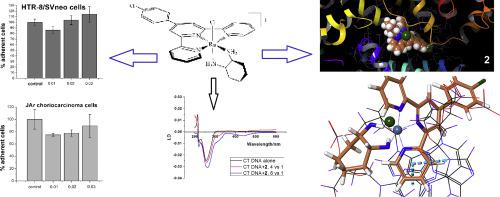当前位置:
X-MOL 学术
›
J. Inorg. Biochem.
›
论文详情
Our official English website, www.x-mol.net, welcomes your feedback! (Note: you will need to create a separate account there.)
Anti-adhesive action of novel ruthenium(II) chlorophenyl terpyridine complexes with a high affinity for double-stranded DNA: in vitro and in silico.
Journal of Inorganic Biochemistry ( IF 3.9 ) Pub Date : 2020-04-28 , DOI: 10.1016/j.jinorgbio.2020.111090 Romana Masnikosa 1 , Milan M Milutinović 2 , Ivo Crnolatac 3 , Aleksandar Tot 4 , Suzana Veličković 1 , Žanka Bojić-Trbojević 5 , Ana Rilak-Simović 6
Journal of Inorganic Biochemistry ( IF 3.9 ) Pub Date : 2020-04-28 , DOI: 10.1016/j.jinorgbio.2020.111090 Romana Masnikosa 1 , Milan M Milutinović 2 , Ivo Crnolatac 3 , Aleksandar Tot 4 , Suzana Veličković 1 , Žanka Bojić-Trbojević 5 , Ana Rilak-Simović 6
Affiliation

|
Interactions of three Ru(II) chlorophenyl terpyridine complexes: [Ru(Cl-Ph-tpy)(en)Cl]Cl (1), [Ru(Cl-Ph-tpy)(dach)Cl]Cl (2) and [Ru(Cl-Ph-tpy)(bpy)Cl]Cl (3) (Cl-Ph-tpy = 4'-(4-chlorophenyl)-2,2':6',2''-terpyridine, en = 1,2-diaminoethane, dach = 1,2-diaminocyclohexane, bpy = 2,2'-bipyridine) with human serum albumin (HSA), calf thymus DNA and a double-helical oligonucleotide d(CGCGAATTCGCG)2 (1BNA) were examined. Fluorescence emission studies were used to assess the interactions of complexes with HSA, which were of moderate strength for 1 and 2. Molecular docking allowed us to predict mostly π-π stacking and van der Waals interactions between the complexes and the protein. We suggest that the complexes bind to a novel site on HSA, which is different from its druggable sites I, II or III. We suggest a partial intercalation of complexes through the minor groove as a possible mode of interaction with double-helical DNA. Finally, when applied to normal extravillous cell line HTR8/SVneo and JAr choriocarcinoma cell line, complexes 1 and 2 exerted anti-adhesive properties at very low doses, whereas complex 3 had a negligible effect. The obtained results are completion of our studies of Ru(II) terpyridyl complexes that carry N-N ancillary ligands. We suggest a new research direction towards studying the cellular effects of Ru(II) polypyridyl compounds.
中文翻译:

对双链DNA具有高亲和力的新型钌(II)氯苯基叔吡啶复合物的抗粘连作用:体外和计算机模拟。
三种Ru(II)氯苯基叔吡啶配合物的相互作用:[Ru(Cl-Ph-tpy)(en)Cl] Cl(1),[Ru(Cl-Ph-tpy)(dach)Cl] Cl(2)和[ Ru(Cl-Ph-tpy)(bpy)Cl] Cl(3)(Cl-Ph-tpy = 4'-(4-氯苯基)-2,2':6',2''-叔吡啶,en = 1检测了具有人类血清白蛋白(HSA),小牛胸腺DNA和双螺旋寡核苷酸d(CGCGAATTCGCG)2(1BNA)的1,2-二氨基乙烷,dach = 1,2-二氨基环己烷,bpy = 2,2'-联吡啶)。荧光发射研究用于评估复合物与HSA的相互作用,HSA的强度分别为1和2。分子对接使我们能够预测大多数π-π堆积和复合物与蛋白质之间的范德华相互作用。我们建议该复合物绑定到HSA上的一个新位点,这不同于其可药用位点I,II或III。我们建议通过小沟复杂地部分插入作为与双螺旋DNA相互作用的一种可能模式。最后,当应用于正常的绒毛外细胞系HTR8 / SVneo和JAr绒毛膜癌细胞系时,复合物1和2在非常低的剂量下具有抗粘着性,而复合物3的作用可忽略不计。获得的结果完成了我们对带有NN辅助配体的Ru(II)吡啶基配合物的研究。我们建议研究Ru(II)聚吡啶基化合物的细胞效应的新研究方向。而复合物3的影响可忽略不计。获得的结果完成了我们对带有NN辅助配体的Ru(II)吡啶基配合物的研究。我们建议研究Ru(II)聚吡啶基化合物的细胞效应的新研究方向。而复合物3的影响可忽略不计。获得的结果完成了我们对带有NN辅助配体的Ru(II)吡啶基配合物的研究。我们建议研究Ru(II)聚吡啶基化合物的细胞效应的新研究方向。
更新日期:2020-04-28
中文翻译:

对双链DNA具有高亲和力的新型钌(II)氯苯基叔吡啶复合物的抗粘连作用:体外和计算机模拟。
三种Ru(II)氯苯基叔吡啶配合物的相互作用:[Ru(Cl-Ph-tpy)(en)Cl] Cl(1),[Ru(Cl-Ph-tpy)(dach)Cl] Cl(2)和[ Ru(Cl-Ph-tpy)(bpy)Cl] Cl(3)(Cl-Ph-tpy = 4'-(4-氯苯基)-2,2':6',2''-叔吡啶,en = 1检测了具有人类血清白蛋白(HSA),小牛胸腺DNA和双螺旋寡核苷酸d(CGCGAATTCGCG)2(1BNA)的1,2-二氨基乙烷,dach = 1,2-二氨基环己烷,bpy = 2,2'-联吡啶)。荧光发射研究用于评估复合物与HSA的相互作用,HSA的强度分别为1和2。分子对接使我们能够预测大多数π-π堆积和复合物与蛋白质之间的范德华相互作用。我们建议该复合物绑定到HSA上的一个新位点,这不同于其可药用位点I,II或III。我们建议通过小沟复杂地部分插入作为与双螺旋DNA相互作用的一种可能模式。最后,当应用于正常的绒毛外细胞系HTR8 / SVneo和JAr绒毛膜癌细胞系时,复合物1和2在非常低的剂量下具有抗粘着性,而复合物3的作用可忽略不计。获得的结果完成了我们对带有NN辅助配体的Ru(II)吡啶基配合物的研究。我们建议研究Ru(II)聚吡啶基化合物的细胞效应的新研究方向。而复合物3的影响可忽略不计。获得的结果完成了我们对带有NN辅助配体的Ru(II)吡啶基配合物的研究。我们建议研究Ru(II)聚吡啶基化合物的细胞效应的新研究方向。而复合物3的影响可忽略不计。获得的结果完成了我们对带有NN辅助配体的Ru(II)吡啶基配合物的研究。我们建议研究Ru(II)聚吡啶基化合物的细胞效应的新研究方向。



























 京公网安备 11010802027423号
京公网安备 11010802027423号